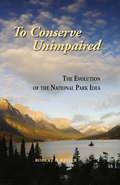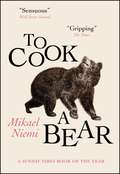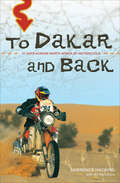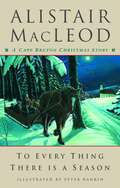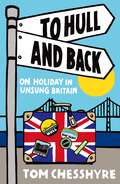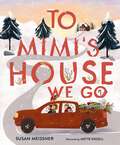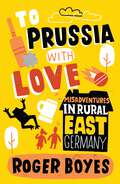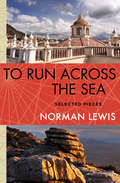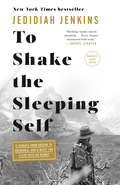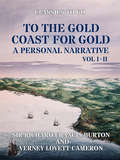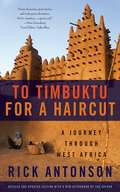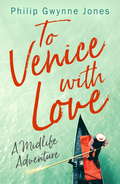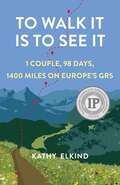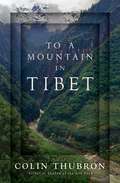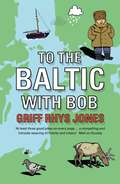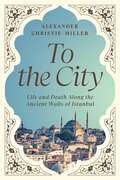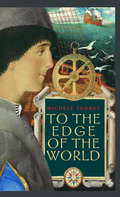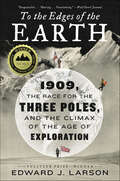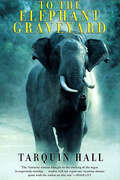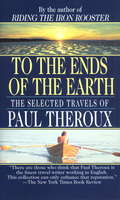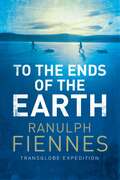- Table View
- List View
To Conserve Unimpaired
by Robert B. KeiterWhen the national park system was first established in 1916, the goal "to conserve unimpaired" seemed straightforward. But Robert Keiter argues that parks have always served a variety of competing purposes, from wildlife protection and scientific discovery to tourism and commercial development. In this trenchant analysis, he explains how parks must be managed more effectively to meet increasing demands in the face of climate, environmental, and demographic changes. Taking a topical approach, Keiter traces the history of the national park idea from its inception to its uncertain future. Thematic chapters explore our changing conceptions of the parks as wilderness sanctuaries, playgrounds, educational facilities, and more. He also examines key controversies that have shaped the parks and our perception of them. Ultimately, Keiter demonstrates that parks cannot be treated as special islands, but must be managed as the critical cores of larger ecosystems. Only when the National Park Service works with surrounding areas can the parks meet critical habitat, large-scale connectivity, clean air and water needs, and also provide sanctuaries where people can experience nature. Today's mandate must remain to conserve unimpaired--but Keiter shows how the national park idea can and must go much farther. Professionals, students, and scholars with an interest in environmental history, national parks, and federal land management, as well as scientists and managers working on adaptation to climate change should find the book useful and inspiring.
To Cook a Bear: A Novel
by Mikael Niemi"So much to relish here . . . the plot is gripping, there's a beautifully handled thread on reading and writing, and the writing is just lovely!" DIANE SETTERFIELD, author of Once Upon A River"The year's most memorable narrator . . . An unusual and intriguing crime story" SUNDAY TIMES BOOKS OF THE YEAR"Niemi succeeds in constructing a story that works as a murder mystery and as a compelling study of a dangerously inward-looking community" SUNDAY TIMES"A riveting, psychologically astute mystery . . . It is not to be missed" BOOKLIST"An original and gripping crime story" THE TIMES**NOW SHORTLISTED FOR THE CWA INTERNATIONAL DAGGER**It is 1852, and in Sweden's far north, deep in the Arctic Circle, charismatic preacher and Revivalist Lars Levi Læstadius impassions a poverty-stricken congregation with visions of salvation. But local leaders have reason to resist a shift to temperance over alcohol.Jussi, the young Sami boy Læstadius has rescued from destitution and abuse, becomes the preacher's faithful disciple on long botanical treks to explore the flora and fauna. Læstadius also teaches him to read and write - and to love and fear God. When a milkmaid goes missing deep in the forest, the locals suspect a predatory bear is at large. A second girl is attacked, and the sheriff is quick to offer a reward for the bear's capture. Using early forensics and daguerreotype, Læstadius and Jussi find clues that point to a far worse killer on the loose, even as they are unaware of the evil closing in around them. To Cook a Bear explores how communities turn inwards, how superstition can turn to violence, and how the power of language can be transformative in a richly fascinating mystery."Superb suspense . . . Simply a great literary experience!" V.G. (Sweden) "A masterpiece of narrative" La Vanguardia (Spain)"A philosophical novel, a crime novel, a historical novel and a coming-of-age story complement one another" La Stampa (Italy)"One is transported into a strange time and a fascinating world that is both beautiful and brutal" Politiken (Denmark)"Formidable delivery . . . Unlike anything else you have read . . . An incredible novel" AdresseavisenTranslated from the Swedish by Deborah Bragan-Turner
To Dakar and Back: 21 Days Across North Africa by Motorcycle
by Lawrence HackingIn this adventure motorsports memoir, the first Canadian motorcycle racer to complete the infamous Paris-Dakar Rally recounts his incredible journey. The Paris-Dakar Rally is is without question the most arduous and notorious off-road motorsports event on the planet. Since its inception in 1979, it has attracted more than three thousand adventurers from all walks of life. The men and women who have taken up the &“Dakar challenge&” have at least one thing in common: a desire to measure themselves against the desolate sands of the Sahara. In 2001, Canadian adventure racer Lawrence Hacking entered what would be the last rally on the iconic route from Paris to Dakar. In To Dakar and Back, Hacking, in collaboration with motorsport journalist Wil De Clercq, recounts the three weeks of blood, sweat, and tears that took him on that ten thousand kilometer journey in the heat of competition from the glitzy streets of the French capital through the hinterland of North Western Africa and the triumph of self-realization.
To Every Thing There Is a Season: A Cape Breton Christmas Story
by Alistair MacleodThe story is simple, seen through the eyes of an 11-year-old boy. As an adult he remembers the way things were back home on the farm on the west coast of Cape Breton. The time was the 1940s, but the hens and the cows and the pigs and the sheep and the horse made it seem ancient. The family of six children excitedly waits for Christmas and two-year-old Kenneth, who liked Halloween a lot, asks, “Who are you going to dress up as at Christmas? I think I’ll be a snowman.” They wait especially for their oldest brother, Neil, working on “the Lake boats” in Ontario, who sends intriguing packages of “clothes” back for Christmas. On Christmas Eve he arrives, to the delight of his young siblings, and shoes the horse before taking them by sleigh through the woods to the nearby church. The adults, including the narrator for the first time, sit up late to play the gift-wrapping role of Santa Claus. The story is simple, short and sweet, but with a foretaste of sorrow. Not a word is out of place. Matching and enhancingthe text are black and white illustrations by Peter Rankin, making this book a perfect little gift. For readers from nine to ninety-nine, our classic Christmas story by one of our greatest writers.
To Hull and Back: On Holiday in Unsung Britain
by Tom ChesshyreAs staff travel writer on The Times, Tom Chesshyre had visited over 80 countries on assignment, and wondered: what is left to be discovered? On a mad quest he visited secret spots of Britain in search of the least likely holiday destinations. With a light and edgy writing style, Tom peels back the skin of the unfashionable underbelly of Britain.
To Hull and Back: On Holiday in Unsung Britain
by Tom ChesshyreAs staff travel writer on The Times, Tom Chesshyre had visited over 80 countries on assignment, and wondered: what is left to be discovered? On a mad quest he visited secret spots of Britain in search of the least likely holiday destinations. With a light and edgy writing style, Tom peels back the skin of the unfashionable underbelly of Britain.
To Mimi's House We Go
by Susan MeissnerJoin bestselling author Susan Meissner and other "Mimis" in this Christmas-season poem inspired by the traditional holiday traveling song "Over the River and Through the Woods." Modern families find their way to grandmother's house using a variety of vehicles to celebrate with Mimis, Omas, Gigis, and Nanas.This sweet Christmas storyis for boys and girls 4 to 8 years old and grandmothers of all names and types;explores the different modern modes of transport used to take Christmas journeys;features rhyming text resembling traditional carols and folksongs; andcelebrates the unique ways families celebrate Christmas while showing the common threads of food, family, and love in them all.To Mimi's House We Go combines the magic of Christmastime with sweet memories of time with Grandma in an adventurous romp through country and city, from coast to coast.
To Prussia With Love: Misadventures in Rural East Germany
by Roger BoyesIn a desperate attempt to save his relationship with girlfriend Lena and take a break from the world of journalism, Roger Boyes agrees to leave Berlin for deepest, darkest Brandenburg and decides to set up a B&B in a run-down old schloss that Lena has inherited. Farce meets romance in this follow-up to the successful A Year in the Scheisse.
To Prussia With Love: Misadventures in Rural East Germany
by Roger BoyesIn a desperate attempt to save his relationship with girlfriend Lena and take a break from the world of journalism, Roger Boyes agrees to leave Berlin for deepest, darkest Brandenburg and decides to set up a B&B in a run-down old schloss that Lena has inherited. Farce meets romance in this follow-up to the successful A Year in the Scheisse.
To Rainbow Valley
by Irene Bennett BrownWhen Cotton's family is dusted off their Kansas farm, the journey to their new home in Oregon is riddled with difficulties.<P> This is a 1935 dust-bowl saga of the Baldwin family's trip across a depression-torn America, telling of thirteen-year-old Cotton's painful growth into manhood and his family's proud determination to begin a new life.
To Run Across the Sea: Selected Pieces
by Norman LewisAn engrossing collection of travel essays from esteemed writer Norman LewisAuberon Waugh called Norman Lewis &“the best travel writer of our age, if not the best since Marco Polo,&” and here, Lewis&’s trademark elegant prose is on display, along with his uncanny ability to travel to a place at an important cultural moment. Whether hunting for treasure in Bolivia, discovering forgotten pyramids, or feeding sharks, he draws us into what he calls &“the seductions of travel&” with ease, delivering cultural experiences with his usual depth, integrity, and elegance.
To Shake the Sleeping Self: A Journey from Oregon to Patagonia, and a Quest for a Life with No Regret
by Jedidiah JenkinsFrom travel writer Jedidiah Jenkins comes a long-awaited memoir of adventure, struggle, and lessons learned while bicycling the 14,000 miles from Oregon to Patagonia. <P><P>On the eve of turning thirty, terrified of being funneled into a life he didn't choose, Jedidiah Jenkins quit his dream job and spent the next sixteen months cycling from Oregon to Patagonia. He chronicled the trip on Instagram, where his photos and profound reflections on life soon attracted hundreds of thousands of followers and got him featured by National Geographic and The Paris Review. <P><P>In this unflinchingly honest memoir, Jed narrates the adventure that started it all: the people and places he encountered on his way to the bottom of the world, and the internal journey that prompted it. <P><P>As he traverses cities, mountains, and inner boundaries, Jenkins grapples with the questions of what it means to be an adult, his struggle to reconcile his sexual identity with his conservative Christian upbringing, and his belief in travel as a way to "wake us up" to life back home. <P><P>A soul-stirring read for the wanderer in each of us, To Shake the Sleeping Self is an unforgettable reflection on adventure, identity, and a life lived without regret. <P><b>A New York Times Bestseller</b>
To The Gold Coast for Gold A Personal Narrative Vol I & Vol II (Classics To Go)
by Richard Francis Burton(Excerpt): "Western Africa was the first field that supplied the precious metal to mediaeval Europe. The French claim to have imported it from Elmina as early as A.D. 1382. In 1442 Gonçales Baldeza returned from his second voyage to the regions about Bojador, bringing with him the first gold. Presently a company was formed for the purpose of carrying on the gold-trade between Portugal and Africa. Its leading men were the navigators Lanzarote and Gilianez, and Prince Henry 'the Navigator' did not disdain to become a member. In 1471 João de Santarem and Pedro Escobar reached a place on the Gold Coast to which, from the abundance of gold found there, they gave the name of 'São Jorje da Mina,' the present Elmina. After this a flood of gold poured into the lap of Europe; and at last, cupidity having mastered terror of the Papal Bull, which assigned to Portugal an exclusive right to the Eastern Hemisphere, English, French, and Dutch adventurers hastened to share the spoils."
To Timbuktu for a Haircut: A Journey Through West Africa
by Rick AntonsonTimbuktu: the African city known to legend as a land of scholars, splendor and mystery, a golden age in the Sahara Desert. But to many it is a vaguely recognizable name - a flippant tag for "the most remote place on earth." With this fabled city as his goal, author Rick Antonson began a month-long trek. His initial plan? To get a haircut. Aided by an adventuresome spirit, Rick endures a forty-five hour train ride, a swindling travel agent, "Third World, three-lane" roads, rivers, and a flat deck ferry boat before finally reaching Timbuktu. Rick narrates the history of this elusive destination through the teachings of his Malian guide Zak, and encounters with stranded tourists, a camel owner, a riverboat captain, and the people who call Timbuktu home.Antonson's eloquence and quiet wit highlight the city's myths--the centuries old capital and traveler's dream--as well as its realities: A city gripped by poverty, where historic treasures lie close to the sands of destruction. Indeed, some 700,000 ancient manuscripts remain there, endangered. Both a travelogue and a history of a place long forgotten, To Timbuktu for a Haircut emerges as a plea to preserve the past and open cultural dialogues on a global scale.The second edition of this important book outlines the volatile political situations in Timbuktu following the spring 2012 military coup in Mali and the subsequent capture of the city by Islamic extremists. Literally, it is a race against time to save the city's irreplaceable artifacts, mosques, and monuments, and to understand why Timbuktu's past is essential to the future of Africa.
To Venice with Love: A Midlife Adventure
by Philip Gwynne Jones'An inspiring, life-affirming story' Reader's Digest Philip and Caroline Jones, a middle-aged couple living in Edinburgh, found themselves facing redundancy and an uncertain future. Until they received some advice from a complete stranger in a pub.Their response was to sell everything in order to move to Venice, in search of a better, simpler life. They were wrong about the 'simpler' bit...To Venice with Love recounts how they arrived in Venice with ten pieces of luggage, no job, no friends and no long-term place to stay. From struggling with the language to battling bureaucracy; the terror of teaching English to Italian teenagers, the company of a modestly friendly cat... and finally, from debugging financial systems on an Edinburgh industrial estate, to building an ordinary life in an extraordinary city, To Venice with Love is a love-letter to a city that changed their lives. It's a story told through the history, music, art, architecture (and, of course, the food) of La Serenissima.
To Venice with Love: A Midlife Adventure
by Philip Gwynne JonesPhilip and Caroline Jones, a middle-aged couple living in Edinburgh, found themselves facing redundancy and an uncertain future. Until they received some advice from a complete stranger in a pub.Their response was to sell everything in order to move to Venice, in search of a better, simpler life. They were wrong about the 'simpler' bit...To Venice with Love recounts how they arrived in Venice with ten pieces of luggage, no job, no friends and no long-term place to stay. From struggling with the language to battling bureaucracy; the terror of teaching English to Italian teenagers, the company of a modestly friendly cat... and finally, from debugging financial systems on an Edinburgh industrial estate, to building an ordinary life in an extraordinary city, To Venice with Love is a love-letter to a city that changed their lives. It's a story told through the history, music, art, architecture (and, of course, the food) of La Serenissima.
To Walk It Is To See It: 1 Couple, 98 Days, 1400 Miles on Europe's GR5
by Kathy ElkindIn 2018, Kathy Elkind and her husband decided to take a grown-up “gap year” in Europe and walk the 1,400-mile Grande Randonnée Cinq (GR5) across The Netherlands, Belgium, Luxembourg, and France.At fifty-seven, Kathy has chosen comfort over hardship: Unlike the Appalachian Trail and the Pacific Coast Trail, the GR5 winds from village to village instead of campsite to campsite. She and Jim get to indulge in warm beds and delicious regional food every night and croissants in the mornings. The GR5 is not all comfort. Walking day after day for ninety-eight days bring sickness, accommodation struggles, language barriers, and storm-shrouded mountains in the Alps. Meanwhile, Kathy finds herself reflecting on difficult topics—primarily, her struggles with dyslexia, overeating, and shame. But she also finds that the walking becomes a moving meditation and the beauty of the landscape heals; she begins to discover her own wise strength; and as the days unfold, she comes to the gratifying realization that a long marriage is like a long trail: there are ups and downs and it takes hard work to keep going, but the beauty along the way is staggering.Written with raw honesty and compassion, and rich with dazzling scenery, To Walk It Is To See It will inspire you to lace up your walking shoes and discover your own path.
To a Mountain in Tibet
by Colin ThubronThis is the account of a journey to the holiest mountain on earth, the solitary peak of Kailas in Tibet, sacred to one-fifth of humankind. To both Buddhists and Hindus it is the mystic heart of the world and an ancient site of pilgrimage. It has never been climbed. Even today, under Chinese domination, the people of four religions circle the mountain in devotion to different gods. Colin Thubron reached it by foot along the Karnali River, the highest source of the Ganges. His journey is an entry into the culture of today's Tibet, and a pilgrimage in the wake his mother's death and the loss of his family. He undertakes it in order to mark the event, to leave a sign of their passage. He also explores his own need for solitude, which has shaped his career as a writer-one who travels to places beyond his own history and culture, writing about them and about the journey. To a Mountain in Tibet is at once a powerful travelogue, a fascinated encounter with alien faith, and an intimate personal voyage. It is a haunting and beautiful book, a rare mix of discovery and loss. In its evocation of landscape and variety of exotic peoples, of mythic and spiritual traditions foreign to our own, it is a spectacular achievement from our greatest living travel writer, an artist of formidable literary gifts, uncanny intuition, and wondrous insight.
To the Baltic with Bob: An Epic Misadventure
by Griff Rhys JonesIn the summer of 2002, two profoundly amateur sailors, Griff and Bob, set off in an elderly yacht for Russia, because, on the map, it looked easier than sailing to Cornwall. They took Baines with them, as he knew how to mend the engine. And this is their story.Over four long months of applied bickering in a vessel no bigger than a London taxi, they visited most of the geographically interesting restaurants on the Baltic seaboard. They sailed, over, and, even at one point, onto the mysterious heart of the Nordic world. They pushed themselves to the very limits of human endurance, before finally agreeing to wash their sleeping bags on a cool cycle at number six.To the Baltic with Bob is the full account of their stirring journey through the longest heat wave the frozen north has ever suffered; of three men in search of the answer to a troubling question: can you really outmanoeuvre a mid-life crisis by running away to sea?
To the City: Life and Death Along the Ancient Walls of Istanbul
by Alexander Christie-MillerWalking along the crumbling defensive walls of Istanbul and talking to those he passes, Alexander Christie-Miller finds a story of the country&’s history, a mirror of its present, and a shadow of its future.Caught between two seas and two continents, Istanbul lies at the center of the most pressing challenges of our time. With environmental decay, rapacious development and tightening authoritarianism straining its social fabric to breaking point, it represents the precipitous moment civilizations around theworld are currently facing. In and around its crumbling Byzantine-era fortifications, Alexander Christie-Miller meets people who are experiencing the looming crisis and fighting back, sometimes triumphing despite the odds. To the City seamlessly blends two narratives: the story of Turkey&’s tumultuous recent past told through the lives of those who live around the walls, and thestory of Ottoman Sultan Mehmet II&’s siege and capture of the city in 1453. That event still looms large in Turkey, as Recep Tayyip Erdogan like a latter-day sultan invokes its memory as part of his effort to transform the country in an echo of its imperial past. This is a meditation on the soul of Istanbul, a paean to its resilience and fortitude. To the City takes us on a narrative journey and along the way, we witness danger, beauty and hope.
To the Edge of the World
by Michele TorreyORPHANED BY THE plague and penniless, Mateo must find his way in the world. By chance he is made a cabin boy on the celebrated voyage of Captain-General Ferdinand Magellan. The destination is secret, but the crew whispers that Magellan will be the first to sail east to the Spice Islands by goingwest—and everyone shall return with untold riches. At sea, Mateo discovers the meaning of friendship, loyalty, and hard work, as well as the delight of first love. But when the ocean rages and brother turns against brother, both Mateo and Magellan are in danger—and it’s not clear ifanyonewill survive. . . . “Torrey deftly maintains the taut thread of adventure that, along with the cast of memorable characters, keep the pages turning. ”—Publishers Weekly, Starred “This deserves to be in the hands of every reader who loves history and adventure. ”—Kirkus Reviews From the Hardcover edition.
To the Edges of the Earth: 1909, the Race for the Three Poles, and the Climax of the Age of Exploration
by Edward J. LarsonWinner of the National Outdoor Book Award From the Pulitzer Prize-winning historian, a "suspenseful" (WSJ) and "adrenaline-fueled" (Outside) entwined narrative of the most adventurous year of all time, when three expeditions simultaneously raced to the top, bottom, and heights of the world. As 1909 dawned, the greatest jewels of exploration—set at the world’s frozen extremes—lay unclaimed: the North and South Poles and the so-called “Third Pole,” the pole of altitude, located in unexplored heights of the Himalaya. Before the calendar turned, three expeditions had faced death, mutiny, and the harshest conditions on the planet to plant flags at the furthest edges of the Earth.In the course of one extraordinary year, Americans Robert Peary and Matthew Henson were hailed worldwide at the discovers of the North Pole; Britain’s Ernest Shackleton had set a new geographic “Furthest South” record, while his expedition mate, Australian Douglas Mawson, had reached the Magnetic South Pole; and at the roof of the world, Italy’s Duke of the Abruzzi had attained an altitude record that would stand for a generation, the result of the first major mountaineering expedition to the Himalaya's eastern Karakoram, where the daring aristocrat attempted K2 and established the standard route up the most notorious mountain on the planet. Based on extensive archival and on-the-ground research, Edward J. Larson weaves these narratives into one thrilling adventure story. Larson, author of the acclaimed polar history Empire of Ice, draws on his own voyages to the Himalaya, the arctic, and the ice sheets of the Antarctic, where he himself reached the South Pole and lived in Shackleton’s Cape Royds hut as a fellow in the National Science Foundations’ Antarctic Artists and Writers Program. These three legendary expeditions, overlapping in time, danger, and stakes, were glorified upon their return, their leaders celebrated as the preeminent heroes of their day. Stripping away the myth, Larson, a master historian, illuminates one of the great, overlooked tales of exploration, revealing the extraordinary human achievement at the heart of these journeys.
To the Elephant Graveyard
by Tarquin Hall“Introduces us to the darker side of the Asian elephant. It is more of a thriller than a straightforward travel book . . . insightful and sensitive.” —Literary ReviewOn India’s northeast frontier, a killer elephant is on the rampage, stalking Assam’s paddy fields and murdering dozens of farmers. Local forestry officials, powerless to stop the elephant, call in one of India’s last licensed elephant hunters and issue a warrant for the rogue’s destruction. Reading about the ensuing hunt in a Delhi newspaper, journalist Tarquin Hall flies to Assam to investigate. To the Elephant Graveyard is the compelling account of the search for a killer elephant in the northeast corner of India, and a vivid portrait of the Khasi tribe, who live intimately with the elephants. Though it seems a world of peaceful coexistence between man and beast, Hall begins to see that the elephants are suffering, having lost their natural habitat to the destruction of the forests and modernization. Hungry, confused, and with little forest left to hide in, herds of elephants are slowly adapting to domestication, but many are resolute and furious. Often spellbinding with excitement, like “a page-turning detective tale” (Publishers Weekly), To the Elephant Graveyard is also intimate and moving, as Hall magnificently takes us on a journey to a place whose ancient ways are fast disappearing with the ever-shrinking forest.“Hall is to be congratulated on writing a book that promises humor and adventure, and delivers both.” —The Spectator“Travel writing that wonderfully hits on all cylinders.” —Booklist“A wonderful book that should become a classic.” —Daily Mail
To the Ends of the Earth
by Paul Theroux"Travel writing at its best."THE HOUSTON POSTAuthor and travel writer Paul Theroux does what no one else can: he travels to the isolated, unusual, and fascinating spots of the world, and creates an elegy to them that makes readers feel they are traveling with him. Evocative, breathtaking, intriguing, here is the armchair traveler's guide to the sites of the world he makes us feel we know.From the Paperback edition.
To the Ends of the Earth
by Ranulph FiennesRanulph Fiennes has entered the public imagination as the intrepid explorer par excellance. Taunted by his wife over the challenge of the never-before attempted circumpolar navigation of the globe, he set off in 1979 on a gruelling 52,000 mile adventure. Together with fellow members of 21 SAS regiment, Fiennes left from Greenwich, travelling over land, passing through both ends of the polar axis. Completed over two years later, it was the first circumpolar navigation of the globe, and justifiably entered Fiennes into the record books.TO THE ENDS OF THE EARTH is the record of that journey. It captures the natural beauty of the landscapes they passed through, and the cameraderie that necessarily grows between men who had served in the British forces' elite regiment and were now throwing themselves into danger of a different sort. Time and again, the expedition found themselves in life-threatening situations, weaving through the pack ice of the Arctic Ocean or sharing a single sleeping bag to ward off the -40 degrees celsius Arctic night. The calm and measured approach which made Fiennes such a great expedition leader shines through TO THE ENDS OF THE EARTH, deftly recreating the last unexplored regions on earth.It is also a book which lays the foundations for what was to come for Fiennes, confirming a need to exist outside the comfortable norms the rest of us inhabit. As the expedition progresses, there is also a mounting sense of tension as attainment of the final goal also spells the end of the adventure. TO THE ENDS OF THE EARTH is a compelling account of one journey and Fiennes' drive to push himself to ever further extremes.
